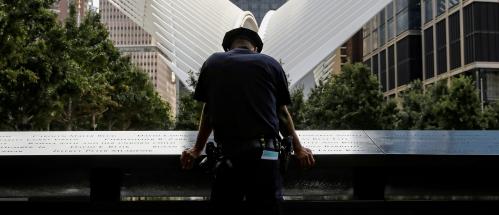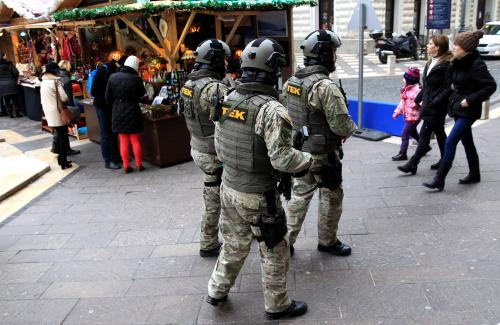After 9/11, writes Daniel Byman, the United States focused on terrorism almost exclusively as a problem related to jihadis. As a result of the country’s skewed perception of terrorism, its legal framework offers little guidance for how to handle terrorist acts not committed by jihadis. This piece originally appeared on ForeignPolicy.com.
On Saturday, a shooter gunned down at least 11 people at the Tree of Life synagogue in Pittsburgh, the single deadliest anti-Semitic attack in American history. U.S. President Donald Trump declared it a “wicked act of mass murder.” As the country grieved, police arrested 46-year-old Robert Bowers, the apparent gunman, who had barricaded himself in the synagogue after a shootout with the police. Before the attack, Bowers had repeatedly posted vicious anti-Semitic slurs on Gab, a social media site popular with white nationalists. He was heard shouting, “All Jews must die,” as he entered the synagogue.
Some observers have started to call the attack an act of terrorism. Others have shied away from using the term. But it’s probably right to use it—and doing so could spur the United States to put more resources into fighting anti-Semites, white nationalists, and violent domestic extremists.
In the general discourse, people tend to use the label “terrorism” to demonize their opponents while avoiding it for groups that they see as sympathetic. As the terrorism analyst Brian Jenkins observed in 1981, “Terrorism is what the bad guys do.” To some degree, that’s still where we are: Think of how critics of Israel call it a “terrorist nation,” for example, and how U.S. Interior Secretary Ryan Zinke blamed the California wildfires in part on environmental “terrorist groups.”
Expert and legal definitions, by contrast, tend to be more precise. Bruce Hoffman, a leading scholar in this field, defines terrorism as a sub-state group’s use of political violence (or the threat of it) in order to create a broader psychological impact. The U.S. government similarly defines terrorism as “the unlawful use of force and violence against persons or property to intimidate or coerce a government, the civilian population, or any segment thereof, in furtherance of political or social objectives.”
As I’ve previously written, these definitions stress violence, politics, and the broader impact that the terrorists want to create. Whether a person kills innocents in the name of the Islamic State or the Ku Klux Klan—or, for that matter, mows down 10 people with a van out of allegiance to a movement that channels male sexual frustration—it’s not the type or legitimacy of the political cause that matters. Rather, it is simply that the attacker had one, regardless of how stupid it might be.
After the 9/11 attacks, though, the United States focused on terrorism almost exclusively as a problem related to jihadis. Much less attention was paid to far-right violence, such as that committed by neo-Nazis, sovereign citizens, anti-immigrant groups, and others. That was a mistake. Since 9/11, right-wing violence has killed 86 people in the United States. (Jihadis have killed 104.) After Saturday’s shooting, we’re probably going to have to add at least another 11 to the right-wing total.
As a result of the country’s skewed perception of terrorism, its legal framework offers little guidance for how to handle terrorist acts not committed by jihadis. For one, many of the elements that characterize domestic extremist groups—such as conspiratorial anti-Semitism—are protected as free speech.
Further, there is no official list of domestic terrorist groups. By contrast, the State Department’s list of foreign terrorist organizations tells law enforcement, businesses, and others exactly which groups are illegal. Without a domestic list, extremist groups are freer to raise money, recruit, and operate. Social media companies, for example, take down content linked to the Islamic State. They don’t do as much to delete white supremacist content, which is often legal.
Beyond that, the implications of the federal government calling something domestic terrorism are not always clear. Bowers, for example, will presumably be charged with multiple counts of murder, among other crimes. Adding terrorism to the list doesn’t offer additional legal advantages. In the U.S. system, it is usually the state, not the federal government, that handles violent crimes. The federal government focuses on those crimes and issues that cross state borders and require federal resources to address. But for now, the legal framework for including domestic terrorist groups that aren’t linked to international terrorist organizations is somewhat lacking.
That doesn’t necessarily mean that the Trump administration and others should throw up their hands and avoid using the “T-word” to describe the Pittsburgh attack and tragedies like it. If the government started seeing violent anti-Semitic or white supremacist groups as more like jihadist groups, several things could change.
First, doing so might mean more resources devoted to tracking domestic terrorists. Right now, only a tiny slice of the FBI counterterrorism budget goes to investigating right-wing extremists. The Trump administration downplays the danger of such terrorism and has cut resources for programs meant to address it. Looking at crimes like the attack in Pittsburgh through the lens of terrorism would mean more agents, more prosecutors, and more money for counterterrorism programs.
Second, the “terrorism” label could start to push the government to act more quickly at the first hint of possible violence by right-wing and other extremists. If a suspected terrorist tried to acquire bomb-making materials or a gun, the police might swoop in. It is hard to imagine armed Islamic State supporters marching through town singing the praises of Islamic law while the government claims it has no power to act due to the First and Second Amendments. It is easier to do so if the slogans are anti-Semitic and racist.
By calling right-wing terrorism what it is, that will change.
Third, clarity about which activities are and aren’t terrorism would help Washington press technology companies to be more aggressive in taking down anti-Semitic, white supremacist, and other inciting accounts.
This might seem like a tall order, but domestic terrorism often has a bigger political impact than jihadi violence. A foreign-based attack brings America together in the face of tragedy. But right-wing (and left-wing) violence is more likely to divide the country. Just this week, for example, 56-year-old Cesar Sayoc reportedly sent explosive packages to CNN, Democratic politicians, and others seen as “enemies” of Trump. Some right-wing voices immediately embraced conspiracy theories rather than recognizing his activities for what it was. Domestic terrorists poke at bigger political wounds than do jihadis, with at least some Americans sympathizing with their cause even as they reject their violent means.
In turn, observers often avoid the word “terrorism” because peaceful proponents of right-wing and left-wing causes don’t want to be lumped together, even by weak association, with terrorists. We can and should recognize that most political groups of all stripes abhor violence. Doing so—while also acknowledging that the groups and individuals who don’t belong in a separate category—will better enable the United States to isolate extremists and cut them off before the next tragedy.









Commentary
When to call a terrorist a terrorist
October 29, 2018